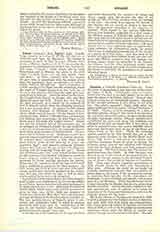

Ispahan, a Catholic Armenian Latin see. Under the name of Aspandana it was once one of the principal towns of Media. Christianity must have penetrated into the land at an early period, for in 424 we meet the name of its bishop, Aphraat. Several other bishops of this see are historically known: Abraham in 497, another Abraham in 554, Ahron in 576 (Chabot, “Synodicon orientale”, Paris, 1902, 674), two others in 987 and 1111 (Lequien, “Oriens Christianus”, II, 1305). Ispahan owes its prosperity to a shah of the Sofis dynasty, Abbas I, who made it his capital at the end of the sixteenth century; he drew thither from all parts merchants, artists, artisans, agriculturists, embellished the town with many fine buildings, and enlarged it to such an extent that it was about six miles in circumference, had nearly 600,000 inhabitants and was looked upon as one of the finest and richest towns in the world. Djulfa, the Armenian quarter, created by the shah himself, was, and is still, separated from Ispahan by the Zender ‘Roud river. About 1600 Abbas I, desirous of an alliance with Christian European States in order to destroy the Ottoman power, entered into relations with Clement VIII and the King of Spain, and both promised him missionaries. The first to come were Portuguese Augustinians from Goa (1602). In 1604 the pope, who did not know of the arrival of the Augustinians, entrusted the Persian mission to the Discalced Carmelites, of whom a few settled in Ispahan in December, 1607. Then came French Capuchin missionaries in 1628, French Jesuits in 1645, and Dominicans a little later. Although the shahs did not make the Catholic missionaries welcome, they nevertheless allowed them in the course of the seventeenth century to continue their ministry to the Armenians and Chaldeans, to erect churches and schools, and even to convert a few Moslems. When the celebrated Jesuit, Father Alexander de Rhodes, died, he was given magnificent obsequies. During the entire eighteenth century persecutions were so serious as to cause the departure of the European missionaries, and even the Catholic natives left the town.
The Latin Diocese of Ispahan was created in 1629; in 1638 a second one was created, known as Babylon, and until 1693 both were under one administrator. The bishop generally resided at Ispahan and was still there in 1699, as well as the five religious communities mentioned above, when the Bishop of Ancyra was sent by the pope as ambassador to the shah. The taking of Ispahan by the Afghans in 1722 necessitated the closing of these Catholic establishments. In 1838, when Eugene Bore visited Ispahan, there were but few Catholics left. Propaganda reestablished the mission in 1840, and it was placed in care of the Lazarists. Their superior became Apostolic prefect; a school had already been established at Ispahan. In 1852 liberty of conscience was granted. In 1874, when Rome created the Persian Apostolic Delegation for the Orientals, the Latin Diocese of Ispahan was removed from the jurisdiction of the See of Babylon, of which it had become a suffragan in 1848. Today this diocese directly depends on the Holy See; Msgr. Lesne, its administrator, who is titular Archbishop of Philippopolis and Apostolic delegate, resides at Ourmiah. There are about 350 Catholics of the Latin Rite in Persia, out of a total population of over eight millions; they are under the care of fifteen Lazarist fathers. The Catholic Armenian Diocese of Ispahan, erected on April 30, 1850, is under the jurisdiction of Monsignor Paolo Pietro Sabbaghian, the Armenian Patriarch of Cilicia, and contains about 7700 Catholic Armenians, with eleven secular priests, four churches, and one convent. The faithful in Ispahan proper number 560, out of a population of 80,000 inhabitants; and there are still many in the region of Ourmiah. The Gregorian Armenians, about 50,000 in Persia, are quite numerous at Djulfa, a suburb of Ispahan, and have a bishop of that title.
S. VAILHE

